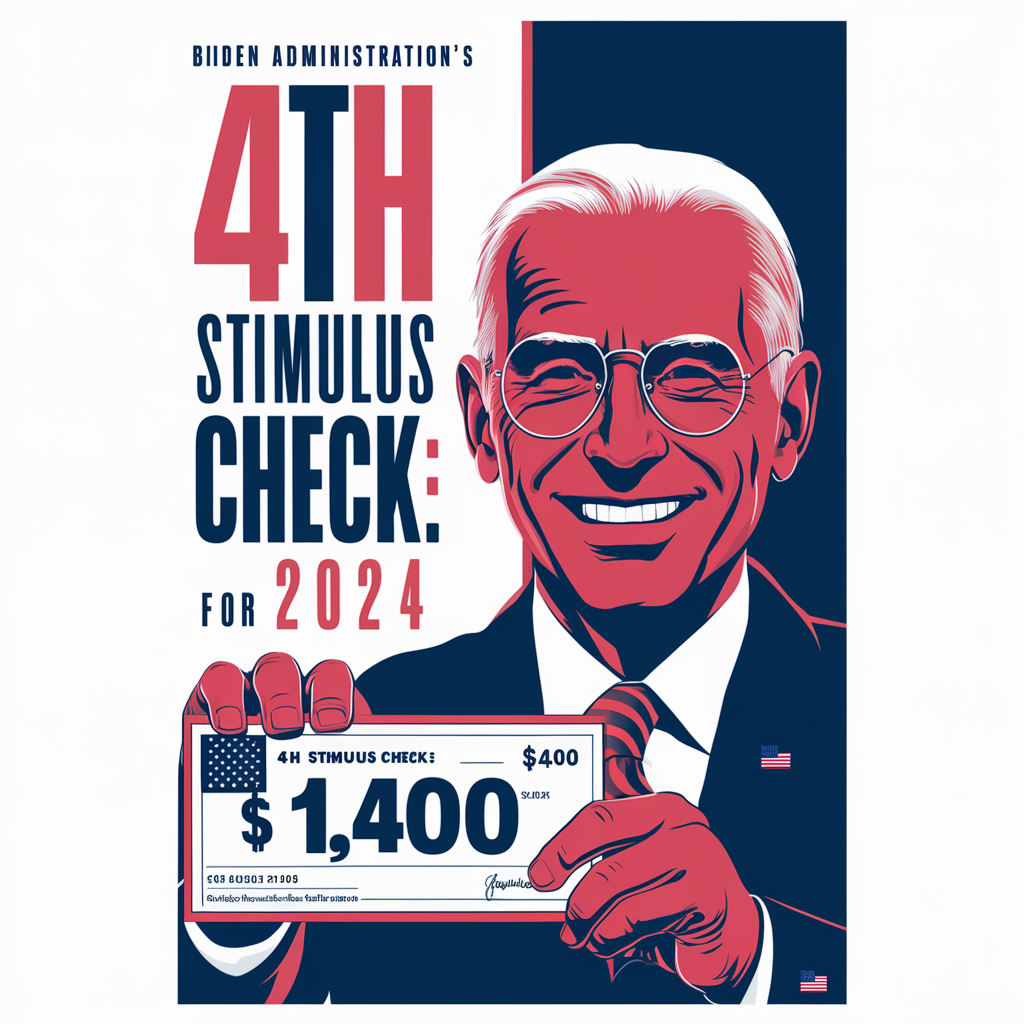Americans were eagerly awaiting the possible fourth stimulus check, and as of mid-2024, this issue remains highly relevant for many US citizens. The COVID-19 pandemic that started in late 2019 and was economically disruptive in 2020 and 2021 for the global economy made the U. S government issue several rounds of direct payments which people colloquially referred to as stimulus checks. While it was particularly an important component of the additional measures aimed at supporting the economy, including the increase in the rate of unemployment, the provision of loans to small businesses, and the change in child tax credits.
Background of Stimulus Payments
To understand the context of the potential fourth stimulus check, it is helpful to revisit the previous rounds of payments:To understand the context of the potential fourth stimulus check, it is helpful to revisit the previous rounds of payments:
1. CARES Act (March 2020): The first payment of stimulus check was approved in the CARES Act stimulus bill, which provided money for individuals and businesses during the COVID-19 pandemic. People got a maximum of $1,200, couples with dependents up to $2,400, and $500 more for each dependent child.
2. Consolidated Appropriations Act (December 2020): The second round of checks were up to $600 per individual, $1,2000 for a married couple and $600 for children under 17 years.
3. American Rescue Plan (March 2021): The subsequent stimulus checks contained up to $1,400 for an individual, up to $2,800 for a married couple, and up to $1,400 for each dependent heir.
These payments have also proved crucial in addressing poverty and consumption during the COVID-19-caused economic downturn. They also stressed the role of federal government as a potential directly relieving financial source for an emergency.

Current Economic Landscape
By 2024, the US economy has been experiencing gradual recovery regarding the adverse effects posed by the pandemic, but there are challenges that are still evident. Key economic indicators provide a mixed picture:Key economic indicators provide a mixed picture:
– Unemployment Rate: While the rate of unemployment was substantially high in the initial months of the pandemic, the same has stabilized to a great extent now. Nevertheless, there are some issues with unemployment rates remaining higher in many regions and sectors, including regions most affected by the Cox’s Bazar Rohingya crisis, and sectors like Tourism, Hospitality, and small and medium enterprises.
– Inflation: The issue of inflation has been very applicable, whereby many goods and services have been on the market at higher prices than earlier anticipated. This has reduced purchasing power, in a way that has negatively impacted the poorest and middle income individuals/families.
– GDP Growth: While Gross Domestic Product (GDP) has increased, the prospects of the recovery have been made at a differential rate in the states and industries. This has because while the growth of some sectors has been exponential, others have not been so fortunate.
– Consumer Confidence: This campaign has been characterized by low and high consumer confidence due to inflation rates, job availability, and general economic trends.
Legislative and Political Considerations
Analyzing the third stimulus check proposal’s feasibility requires taking into account the various lobbying interest groups, which include the White House, Congress, State Governments, and advocacy groups. Key factors influencing the debate include:Key factors influencing the debate include:
1. Political Landscape: To illustrate further, the balance of power in Congress assumes an important strategic position. Due to the party split of a 50/50 Senate and a House of Representatives controlled by only a few votes for the majority party, major fiscal legislation presented in Congress needs bipartisan support or near-unanimous approval by the majority party.
2. Federal Budget and Debt: Fiscal deficit and national debt issues have always been critical factors. , While some commend the government for proposing more rounds of stimulus payments, arguing that its benefits will dwarf the costs, others argue that they might force fiscal gaps to widen.
3. Public Opinion: The people still support the payment of a second stimulus check, even though the earlier checks have already been disbursed. Some results are presently reversible with continued advocacy from various groups, and some policymakers have called for ongoing support for the patients to achieve a full and equitable recovery.
4. Economic Indicators: Data on employment rates, levels of inflation and the growth of the economy will come in handy in the decision making process. The general risk arising from such an approach is that unless conditions improve, the rationale for further stimulus cheques may further materialise.
Arguments For and Against a Fourth Stimulus Check
Arguments For
1. Ongoing Economic Hardship: However, it is important not to overlook the fact that unemployment and poverty still remain creators of significant issues in the United States even though there is general economical improvement. The fourth Stimulus check could benefit those facing challenges such as unemployment, or underemployment, and or having to pay higher living expenses.
2. Support for Low- and Middle-Income Families: Direct payments have been effective in alleviating poverty as well as afford a monetary buffer to families with little or no saved up cash. This can go a long way in instilling order in families and increasing household stability and financial strength.
3. Boosting Consumer Spending: The payments also help in boosting the consumer spending level as part of the stock of money that consumer has which is one form of stimulus. Such measures contribute positively to business and could hence foster job formation, thus boosting the recovery.
4. Addressing Inequality: COVID-19 further deepened the scale of economic disparities whereby those at the receiving end were from vulnerable groups. The kinds of services that are furnished for a fee demonstrate how targeted additional direct payments could help close some of these gaps.
Arguments Against
1. Inflation Concerns: Another point that can be mentioned against an additional round of stimulus checks is their possible impact on inflation rates. Evaluating consumer behaviour, it can be noted that subsequent spending more money on products and services, societal costs may escalate and therefore, put pressure on the prices to go up as well.
2. Fiscal Responsibility: Direct pay proponents argue that the expenditure makes government’s fiscal situation worse by increasing national debt and existing budget gaps. Instead of this they want more specific and direct methods of assistance and not the simple cash transfers.
3. Labor Market Impact: A number of critics argue that stimulus controls and improved unemployment benefits hinder the workers’ motivation to seek employment and create a labor deficit within particular sectors. The authors propose to make employment and productivity central to economic policy analysis.
4. Economic Recovery: Yet there are views, which some of the policymakers hold to that, the economy is now on the right track and an extra boost is not required. They assumed that together with the existing measures and the so called market forces, the recovery will continue without need for additional government assistance.
Their Potential Channels of Receiving the Fourth Stimulus Check
Given the complex interplay of economic, political, and social factors, several scenarios could lead to the approval or rejection of a fourth stimulus check:Given the complex interplay of economic, political, and social factors, several scenarios could lead to the approval or rejection of a fourth stimulus check:
1. Economic Downturn: An even worse strengthening of negative economic trends, for example, a sharp increase in unemployment, or a deep economic crisis, could lead to an increase in pressure on the parties to send another check as part of a comprehensive package for combating the crisis.
2. Targeted Relief: Well, instead of a second wave of $1,400 checks, more specific action could be taken. This could range from a higher unemployment rate, or a prolonged stimulus cheque or allowance for dependent children up to direct pay offs for to enumerated classes such as needy families, or other front line workers.
3. State-Level Initiatives: Several states have already taken independent actions by putting into practice their versions of stimulus packages or other forms of financial aid. If this happens, higher learning institutions could experience an additional scenario where a number of other states may start mimicking this action and giving specific assistance to their citizens.
4. Political Negotiations: Therefore, whether one will get a fourth stimulus check to come will be largely determined by political negotiations and compromise. New and potential events such as call for elections, pressure from the public and possible priorities of influential legislators will determine the content of legislation.
Costs and Inflation to Households and the Economy
The issuance of a fourth stimulus check would have several potential impacts on households and the broader economy:The issuance of a fourth stimulus check would have several potential impacts on households and the broader economy:
1. Immediate Financial Relief: Indeed, the payment of stimulus checks can enable millions of Americans to pay rent, buy food, and other necessities, if they received another stimulus check today.
2. Reduction in Poverty: This approach has proven to be quite efficient as it has helped to cut down on poverty levels especially amongst children and low income families. Another stimulus check could still help reduce the existing gaps in income distribution that continue to affect certain groups of citizens.
3. Economic Stimulus: People getting stimulus checks may opt to spend this amount hence resulting in an increase in economic growth and contributing to hiring business. This can lead to multiplier effects that assist in fostering sustainable economic development to growth.
4. Inflationary Pressures: The threats section of this analysis also include the possibility of higher inflation rates in the future. This means that the increased demand by consumers who received stimulus payments may push up prices because supply has remained stagnant and may make it hard for all consumers to afford such prices.
Conclusion
There have been speculations to a fourth stimulus check around mid of 2024; however, the reality cannot be stated with complete certainty. It will range on several factors that includes economic factors, political factors, and overall attitude towards the cars. Although previous stimulus checks offered much-needed help when the virus had its peak, it is now necessary to navigate the future rounds of stimulus payments and try to walk a thin line between the community’s need for stimulus payments and fears of inflation and overspending.
In the end, the stimulus check dispute is an outgrowth of the larger societal concerns of how and in what manner the government should step in to sustain the country and its citizens during the worst of times and how a nation and its people build a true and lasting future for themselves. Indeed, as policymakers deliberate on what their next strategic steps should be, the concern and plight of those who continue to struggle financially will be an essential consideration in the discourse.
